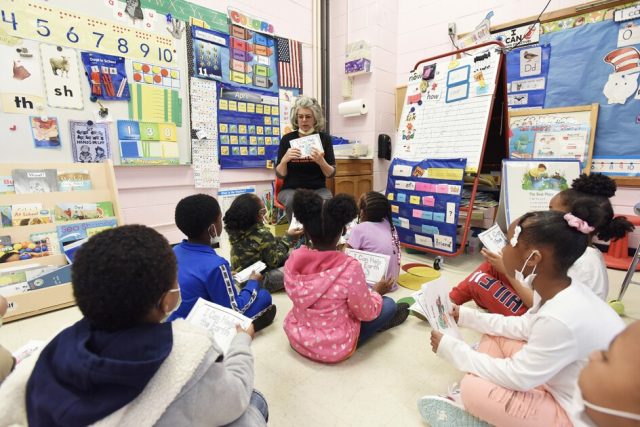[ad_1]
Michigan’s 3rd grade reading retention policy had inequitable impacts, holding back Black and low-income students disproportionately among students whose standardized test scores made them eligible for retention.
The findings, from a study released at the American Educational Research Association conference here, come shortly after Michigan’s Gov. Gretchen Whitmer, a Democrat, signed a bill repealing the retention requirement in late March. The policy originally went into place under former Gov. Rick Snyder, a Republican.
In March, Whitmer said that the decision to repeal the mandate would “put power back into parents’ hands so they can work with their child’s teachers and make decisions that are best for their family.”
The paper raises questions about uneven implementation of what has become a controversial component of literacy legislation in many states.
“While Michigan’s retention mandate is on its face neutral to economic and racial status, we see this disproportionality in the implementation of retention,” said Andrew Utter, a doctoral student in education at Michigan State University, and an author on the paper.
‘Differences in advocacy’ may play a role
In 2016, Michigan became one of 22 states that require retention of students who can’t read at grade level by the end of their 3rd grade year. The goal was to raise their reading scores. At the same time, Michigan also added additional intervention support for students who were struggling in reading.
Students who didn’t meet a cutoff score on the state’s standardized test would be held back, though schools and parents had the option to draw on one of several “good cause exemptions.” These include exemptions for some English learners and students with disabilities, as well as students whose parents think that retention is not in their best interest.
The new paper is the latest in a line of research from the Education Policy Innovation Collaborative at Michigan State University analyzing the implementation and effects of the policy.
For the study, researchers examined state data about students retained at the end of the 2020-21 school year, the first year that the policy was implemented. They found significant racial and economic differences in the policy’s effects. Black students and economically disadvantaged students were more likely to score below the state cutoff and become eligible for retention.
But even among students who score below this cutoff, there are disparities in whether students are actually held back—or whether they are promoted to the next grade through an exemption. Black students were 2.2 percentage points more likely to be held back than retention-eligible white students, while economically disadvantaged students were 3.3 percentage points more likely to be held back than their peers from wealthier families.
A few other patterns emerged, too. Though male students were more likely to be eligible for retention than female students, girls who did fall below the threshold were more likely to be held back than boys who also did. Students in charter schools were also more likely to be retained than students in traditional public schools.
One other factor played a big role: student math scores. When students scored below the cutoff on the state reading test, but scored high on the state math test, they were less likely to be retained. One possible explanation for this, the researchers write, is that “districts and parents use students’ math proficiency to indicate that students do not need to be retained.”
When the researchers controlled for math scores, other student characteristics, and other characteristics that varied between districts, the disparities in retention for female students and Black students disappeared.
But controlling for math scores didn’t have the same effect for students from low-income families—they were still retained at higher rates.
On the other side of this equation are students from higher-income families. For these students, the researchers found that scoring below the cutoff on the state reading test did not have a significant effect on whether students were actually retained.
It’s likely that’s because those students’ parents pressed to get them into the next grade anyway, something prior research has termed “differences in advocacy,” Utter said.
While this study did not specifically examine the question, resources, social capital, and knowledge about the school system might be connected to whether families requested and were granted an exemption.
Research on retention is mixed
The idea behind 3rd grade retention policies is to give students another opportunity to master the reading skills they need to be successful at higher grade levels.
Once students enter upper elementary grades and middle school, reading demands usually become greater—students read more complex texts in English/language arts, and they’re reading more across other subjects, like science and social studies.
As in other states, Michigan’s retention policy was passed as part of a broader early literacy law that aimed to raise student achievement in reading statewide.
The law required that schools identify struggling readers as early as possible, offer them interventions including one-on-one instruction, and create individualized reading plans for them. It also mandated new professional development for teachers and literacy coaching.
Over the past decade, 29 states and the District of Columbia have passed similar legislation that aims to align reading instruction and intervention to evidence-based best practice—some of which also includes retention components.
Still, research on the effect of retaining 3rd graders is mixed.
Recent studies from Florida and Indiana show academic gains that persist over time, while other research has shown only short-term positive effects that then fade out. Other studies link retention to adverse outcomes outside of academics—students who are held back are more likely to be suspended in later years, for example.
From AERA
Education Week is reporting live from AERA, the nation’s premier education research conference. Here’s the latest coverage.
[ad_2]
Source link











